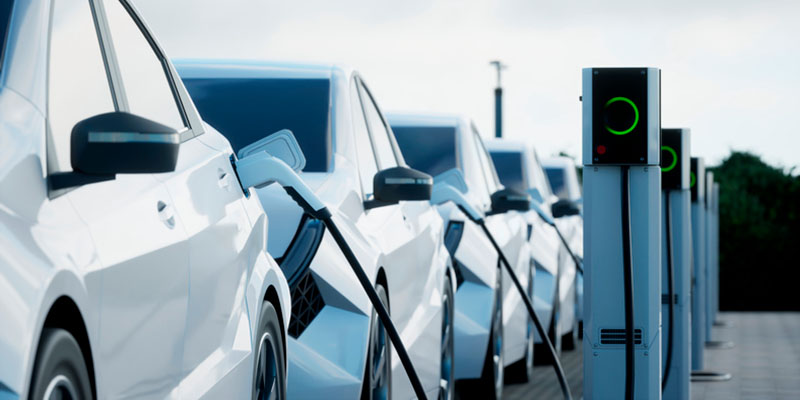
Electric vehicles are everywhere. In the space of just five years, from 2017 to 2022, EV sales have increased tenfold. And all the hype around EVs comes with plenty of opportunities. The EV charging sector is projected to reach $53 billion in 2027.
With available government incentives and relatively low material costs (Level 2 ports can range from about $4,000 to $6,000), electric vehicle charging stations can seem like a clear-cut, easy business opportunity, especially for business owners with electrical or energy backgrounds.
What this means for you as an electrical contractor or energy retrofit service provider, is that the market is ripe for accelerated growth! SnapCount is currently helping clients extend their offering into the growing world of EV charging with:
- EV-specific site audit data collection
- Ready access to leading EV charging manufacturers
- Bid workflow for subcontracting electrical or civil work
- Graphical proposal templates that quickly tell your story of why the customer should work with you
To help you assess if the EV charging market is for you, here are some things to keep in mind before adding EV charging stations to your business.
Research and Planning
While there’s a lot to know before you start some initial preparation will get you and your team ready to embark on a new line of business. You’ll need to consider your location and its EV demand, costs and project set-up time, and plenty of other factors. But you’ll also need to determine the kinds of chargers available for you to install. You have three options.
Level One Chargers
These types of chargers use common 120-volt household outlets. They’re the slowest charging, at speeds of about 3 to 5 miles per hour, but are a good option for home charging.
Level Two Chargers
While these can be installed at home, they’re more expensive and are more common in public charging areas. You can expect faster charging speeds, ranging from 12 to 80 miles per hour.
Level Three Chargers
Unlike the other chargers that use alternating current (AC), level three chargers use direct current (DC). Their higher voltage relegates them to public charging, as homes don’t have the voltage necessary to support them. They supply the fastest charge, at speeds of 3 to 20 miles per minute, compared to the hours needed for the other two levels.
Most commercial clients will opt for a level two or level three charger for their business, depending on anticipated demand.
Take a Strategic Approach
EV charging installation projects are more complex than they might seem. They involve software and commissioning components most electrical projects don’t. So, it’s important to start small, with projects that are reasonably straightforward.
Jason Steiner, VP of Sales with SnapCount customer Resound Energy Services, recommends starting with controlled old access parking garages where there's already capacity.
“You can learn how to commission it and kind of learn the nuances of conduit runs and … understand how power sharing works, all the things that you need to know to design an infrastructure or EV site appropriately before you get into something big.”
Civil Considerations for Your EV Charging Station Project
Steiner also recommends considering the civil aspects of an EV charging installation project. You may not have much experience with electrical projects that involve underground aspects like hidden utility lines and may need professional help from experts who do.
If you don’t have any experience with excavating, Steiner suggests hiring an experienced civil foreman who does. Attempting to do it yourself is just too dangerous and could cost you thousands of dollars.
It’s also important to note that the permits required will be very different than with other projects. You’ll need to go through plan review before the project begins, and you’ll have to allow for plenty of lead time to get that completed. You’ll also need CAD drawings at this stage, so it’s helpful to have someone with CAD knowledge on your team or subcontract someone who does.
EV charging installation projects also include a lot of software and networking elements many electricians may be unfamiliar with. You’ll have to choose a good manufacturing partner and work closely with them, because you’ll need to rely on their expertise and recommendations.
EV Charging Station Power Requirements and Estimation
Understanding power requirements is another crucial step. The good news is that your background as an electrician comes in handy here. You’re probably used to running load calls, using data loggers, and visually auditing a panel to understand capacity usage and availability.
Once you have that information, you can calculate how many chargers you can put in with the client’s existing capacity, and assess whether more is needed.
One thing to take into account is the regulations in your area. Regulations surrounding EV installation projects can vary by state, so be sure to look up the regulations in your area or consult a professional before starting your project.
Make Ready Requirements
Estimating the make-ready requirements for the installation project is another thing to keep in mind. You’ll need to perform an audit and get an understanding of the power that’s available and how many chargers you need to deploy. You’ll also have to consider:
- How many breakers and distributors you need, the cost, and the length of time for installation
- Cost of wire, piping, panels, sub-panels, software, and other materials
- The cost for labor, subcontractors, and partners to assist with elements of the job you don’t have experience with.
Future-Proofing Your EV Charging Stations
The good news? When it comes to future-proofing your EV charging station, the work is mostly done for you. The amount of publicly available charging stations had increased by 40% by 2021, and new stations are popping up all the time. And according to Steiner, the picture is only getting rosier.
Getting Project Ready with SnapCount
You may be thinking that specifying an EV project involves a lot of data and organization to get a compelling quote to the customer. And while this is true, SnapCount has demystified the process and provided a project ready platform to survey, quote and install EV charging equipment in record time.
Consider the experience of Emma Loebker of Donovan Energy in Cincinnati, Ohio. “Prior to using SnapCount for our EV specification, we would take hand-written notes in the field and then use brute force to enter all that data into a spreadsheet. Producing proposals and ultimately vendor purchase orders was just as manual, and all of our data was spread between different spreadsheet files. SnapCount has unified the estimating process, makes changes much easier and organizes all of our project information in one place. For us, SnapCount is a gamechanger”.
But remember, an EV charging project might be unlike any other electrical project you’ve ever done. Though this line of work has the potential to be profitable and grow rapidly over the next couple of years, it takes plenty of preparation and planning, professional support, and specialized knowledge to undertake.
Need more information on EV chargers? Read our guide to the “how” and “why” of EV charging station projects.
To help you assess if the transition into EV charging is right for you now, book a call with one of our experts by clicking the button below.







Share this post: